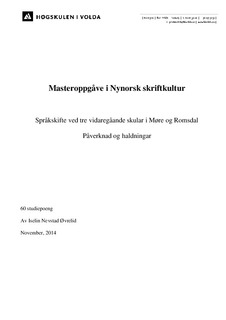| dc.description.abstract | The subject of this master’s thesis is language shift, and the particular objective of the study is to gain further insight into why so many pupils give up their written language «nynorsk» in favor of «bokmål», the more dominating written language in Norway. Much of the theory employed in this study claims that language shifts are quite often and in many rather similar ways determined by regional factors. My work supports this claim, but elaborates on this by showing how this is played out on a minor scale: How the degree of language shifts taking place can differ radically from one school to another despite them being located relatively near to each other within what is regarded as the same region.
This quantitative study includes figures from three junior colleges in the county of Møre og Romsdal and the results are based on 500 respondents. They were given a survey with questions about language shift, influences and attitudes. Despite the differences between the schools included in this study, I still find many similar features amongst pupils that are placed in the same category, regardless of what school they go to. This appears especially when comparing the pupils writing «nynorsk» today and for the pupils that have completed a language shift from «nynorsk» to «bokmål».
One striking aspect of my findings is that as much as 20 percent of those who have completed a language shift from «nynorsk» to «bokmål» feel that they have been influenced to make this shift. The main source of encouragement is found to be their parents, but on second place, notably, the pupils in this study rank their teachers. This is quite remarkable given the official aim of the Norwegian language politics, and I go on to discuss these findings with regards to the language neutrality policy.
Furthermore, the process of language shift among the pupils included in this study seems to start from an early age, it is argued. Although the majority perform their shift when first attending junior college, we find several cases of shifts having been performed before they start junior college. My findings also show that many of the pupils who uses «nynorsk» today, think that they will write «bokmål» in the future. It thus looks like language shift from «nynorsk» to «bokmål» in junior college can be seen as a first period in a process that contains a second period; i.e. after the pupils have graduated and continue their higher education or start working. I leave it to others to find out to what degree this first period influences the second. | nb_NO |
